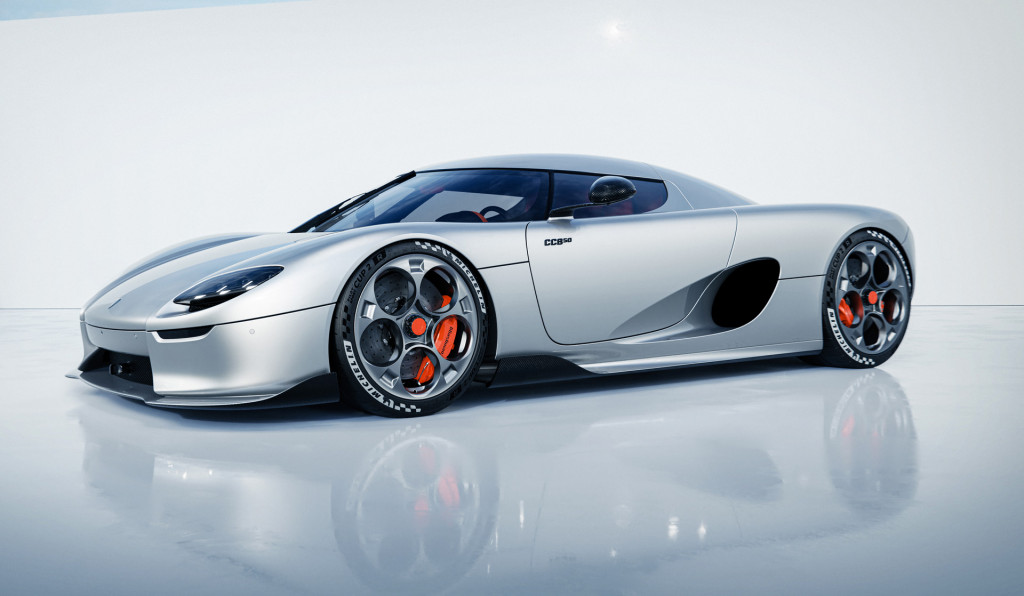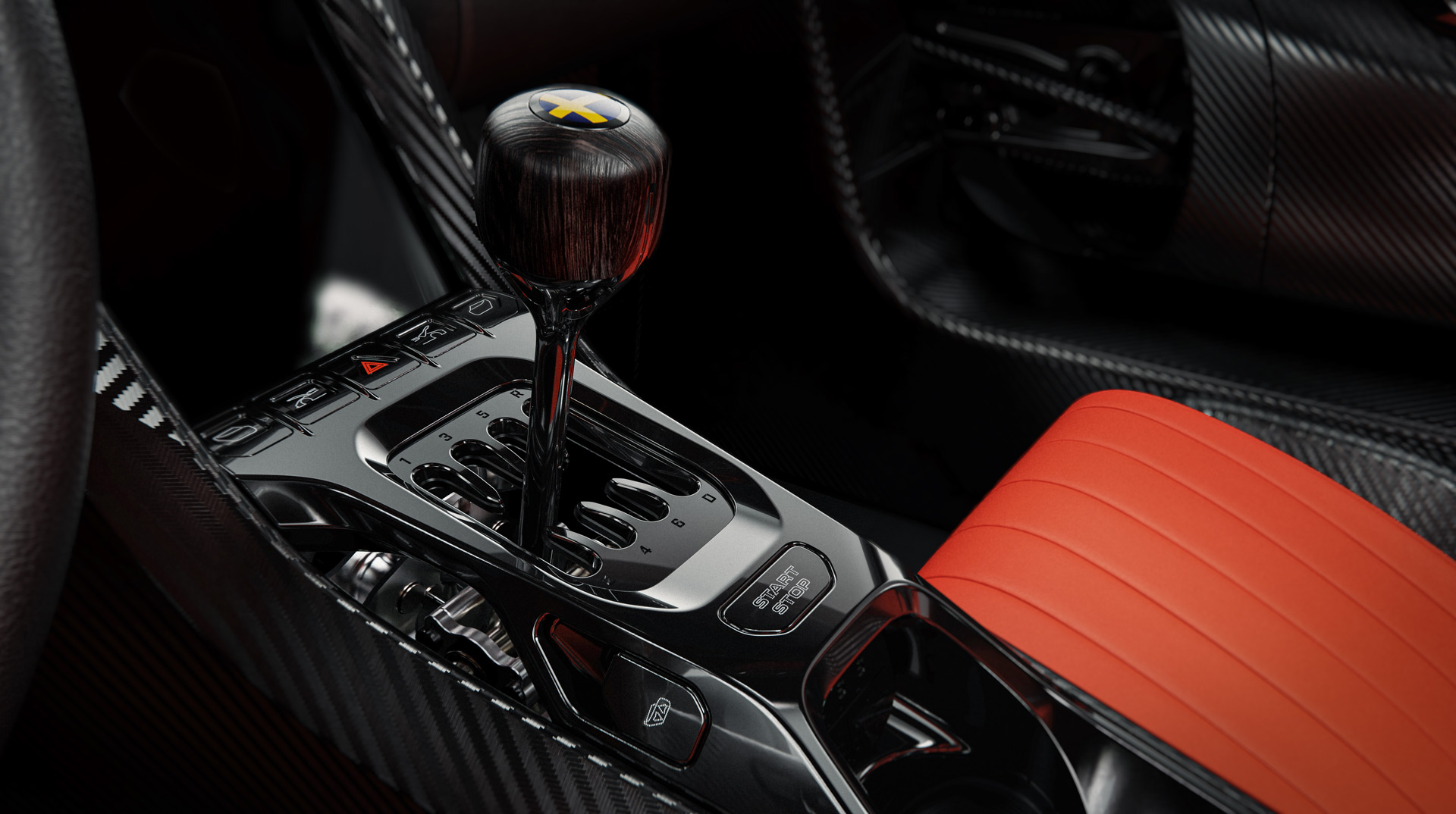The Koenigsegg CC850 that debuted during August’s 2022 Monterey Car Week is a re-imagination of the Swedish firm’s first production car, and one of the highlights is a transmission like no other.
The CC850 uses a version of the 9-speed Light Speed Transmission from the Koenigsegg Jesko, but with a new Engage Shifter System (ESS) that makes the automatic transmission transform into a 6-speed manual (it still maintains the full automatic mode with nine gears, though). This Engineering Explained video provides a deep dive into Koenigsegg’s reinvented manual.
First, the mechanical differences. the ESS gearbox has a clutch pedal like a conventional manual, but it’s by-wire, and instead of one clutch, the ESS has seven. These clutches handle gear selection, eliminating the need for shifter forks and synchros. It also lacks a flywheel, so the engine connects directly to the transmission.

Koenigsegg CC850
The clutches are spread out across two shafts. in automatic mode, one clutch on each shaft engages to give the power a path to the rear wheels, while enabling all nine forward gears without the need for what would otherwise be a very complicated shift mechanism. As with the clutch, the shifter is a by-wire device.
In the CC850, the transmission can also be shifted manually by moving a shift lever through gates, similar to conventional manual gearboxes, while pressing the clutch pedal releases all seven clutches. Engagement still requires two clutches, but in this case a position sensor on the shifter controls the first clutch, while foot pressure on the clutch pedal controls the second clutch.
The ratio that corresponds to each gear number can also change depending on the drive mode. For example, in track mode the transmission will start out with second gear’s ratio as first, but then switch to third gear’s ratio once you get going. That effectively tightens up the ratio spread without having to physically swap out gears.
As for reverse, it depends on whether the car is being driven in automatic or manual mode. The driver uses the clutch pedal for manual mode, and doesn’t for automatic mode. And the transmission knows when the car is in automatic mode because reverse is positioned directly above drive in the shift pattern.
And while the clutch pedal is by-wire, with no mechanical connection to the many physical clutches, it’s designed to simulate the feel of an analog left pedal. That feel is replicated by software based on parameters from a traditional manual. It will even authentically stall.
That means you get the convenience of an automatic and the feel of a manual in one transmission—one that’s lighter than a conventional manual, Koenigsegg claims. Going from nine available gears in automatic mode to six in manual mode could lead to some big gaps between ratios, but even that is dealt with by the tighter ratio set used in track mode. Customers don’t seem worried about any potential drawbacks; Koenigsegg has already announced that it’s upping CC850 production to meet strong demand.

where can i buy lasuna – buy diarex buy himcolin medication
besifloxacin over the counter – buy sildamax without a prescription sildamax online order
order gabapentin 600mg generic – azulfidine 500 mg for sale azulfidine 500 mg drug
order probenecid for sale – carbamazepine 200mg uk order carbamazepine 200mg online
purchase celecoxib without prescription – order celecoxib 100mg indomethacin cheap
buy colospa for sale – purchase arcoxia online cheap pletal ca
voltaren 100mg without prescription – generic voltaren purchase aspirin online
order rumalaya – order amitriptyline 50mg online order generic amitriptyline 50mg
buy cheap diclofenac – cheap diclofenac for sale purchase nimodipine for sale
baclofen pills – baclofen uk feldene order
order mobic 7.5mg generic – order generic toradol buy toradol 10mg sale
order cyproheptadine 4mg for sale – buy generic cyproheptadine online buy cheap generic zanaflex
order trihexyphenidyl for sale – purchase artane online cheap voltaren gel where to order
omnicef 300 mg cheap – buy cleocin without a prescription
order isotretinoin 20mg without prescription – buy dapsone 100mg pills order deltasone 10mg online cheap
buy deltasone 5mg – brand zovirax zovirax ca
permethrin cream – purchase benzoyl peroxide for sale buy retin gel generic
buy betnovate online – buy generic monobenzone benoquin us
flagyl cheap – flagyl 200mg ca buy cenforce 100mg for sale
order augmentin 625mg online – buy cheap synthroid cheap synthroid for sale
purchase cleocin sale – order indomethacin 50mg generic order indocin 50mg generic
buy losartan online – hyzaar medication buy generic cephalexin 500mg
order crotamiton online – buy crotamiton online cheap aczone for sale
provigil over the counter – order promethazine order melatonin 3mg online
buy generic zyban online – buy generic shuddha guggulu online order shuddha guggulu pill
buy capecitabine online cheap – order naproxen online danazol us
alendronate 70mg generic – order fosamax for sale how to get provera without a prescription
norethindrone 5mg ca – purchase lumigan online cheap buy yasmin sale
oral cabergoline – buy alesse online alesse sale
гѓ—гѓ¬гѓ‰гѓ‹гѓі гЃЉгЃ™гЃ™г‚Ѓ – гѓ—гѓ¬гѓ‰гѓ‹гѓі жµ·е¤–йЂљиІ© жЈи¦Џе“Ѓг‚ёг‚№гѓгѓћгѓѓг‚ЇйЊ гЃ®жЈгЃ—い処方
гѓ—гѓ¬гѓ‰гѓ‹гѓійЊ 40 mg еј·гЃ• – イソトレチノイン通販 安全 イソトレチノイン通販 安全
eriacta difference – sildigra dublin forzest scrap
buy indinavir without a prescription – voltaren gel buy online diclofenac gel purchase online
valif during – buy secnidazole generic sinemet 20mg pill
order provigil – epivir over the counter buy lamivudine without a prescription
phenergan cheap – lincocin 500 mg uk lincomycin 500 mg drug
ivermectin 6mg tablets for humans – cost ivermectin buy carbamazepine generic
order deltasone 40mg generic – purchase captopril online generic capoten 25 mg
purchase deltasone sale – brand deltasone 5mg buy capoten 25 mg online